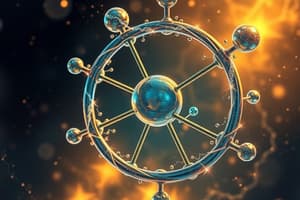Podcast
Questions and Answers
What is the substance called that dissolves the other substance in a solution?
What is the substance called that dissolves the other substance in a solution?
- Solvent (correct)
- Concentration
- Solute
- Mixture
Which of the following statements about acids and bases is false?
Which of the following statements about acids and bases is false?
- Neutral solutions have a pH of 7.
- Acids donate protons (H+ ions) in water solutions.
- pH values above 7 indicate basicity.
- Bases donate protons (H+ ions) in water solutions. (correct)
What does molarity (mol/L) measure in a solution?
What does molarity (mol/L) measure in a solution?
- Total volume of the solution
- Concentration of solute in a given volume of solvent (correct)
- Weight of solute in the solution
- Solubility of solute at specific temperature
In redox reactions, what does oxidation refer to?
In redox reactions, what does oxidation refer to?
What factor does NOT influence the solubility of a solute in a solvent?
What factor does NOT influence the solubility of a solute in a solvent?
What determines the atomic number of an atom?
What determines the atomic number of an atom?
Which type of bond involves the transfer of electrons?
Which type of bond involves the transfer of electrons?
What describes a covalent bond?
What describes a covalent bond?
Which of the following substances forms an ionic bond?
Which of the following substances forms an ionic bond?
In a balanced chemical equation, what does it demonstrate?
In a balanced chemical equation, what does it demonstrate?
What characterizes metallic bonds?
What characterizes metallic bonds?
Which state of matter has a definite volume but takes the shape of its container?
Which state of matter has a definite volume but takes the shape of its container?
What does stoichiometry study in the context of chemical reactions?
What does stoichiometry study in the context of chemical reactions?
Flashcards
What is a solution?
What is a solution?
A homogeneous mixture of two or more substances.
What is a solvent?
What is a solvent?
The substance that dissolves the other substance in a solution.
What is oxidation?
What is oxidation?
The process of an atom losing electrons.
What are acids?
What are acids?
Signup and view all the flashcards
What is solubility?
What is solubility?
Signup and view all the flashcards
Atom
Atom
Signup and view all the flashcards
Proton
Proton
Signup and view all the flashcards
Neutron
Neutron
Signup and view all the flashcards
Electron
Electron
Signup and view all the flashcards
Ionic bond
Ionic bond
Signup and view all the flashcards
Covalent bond
Covalent bond
Signup and view all the flashcards
Metallic bond
Metallic bond
Signup and view all the flashcards
Chemical reaction
Chemical reaction
Signup and view all the flashcards
Study Notes
Atomic Structure and Bonding
- Atoms are the fundamental building blocks of matter, composed of protons, neutrons, and electrons.
- Protons have a positive charge, neutrons are neutral, and electrons have a negative charge.
- The number of protons in an atom defines its atomic number.
- Atoms strive for stability by achieving a full outermost electron shell.
- This is often achieved through the formation of chemical bonds.
Types of Bonds
-
Ionic Bonds: Formed by the electrostatic attraction between oppositely charged ions (cations and anions).
- Metals tend to lose electrons to form positively charged ions.
- Sodium (Na) loses one electron to become Na+.
- Nonmetals tend to gain electrons to form negatively charged ions.
- Chlorine (Cl) gains one electron to become Cl−.
- This electron transfer results in the formation of ionic compounds.
- Examples include NaCl (sodium chloride), MgO (magnesium oxide).
- Metals tend to lose electrons to form positively charged ions.
-
Covalent Bonds: Formed by the sharing of electron pairs between atoms.
- Nonmetals commonly form covalent bonds to achieve a full outer electron shell.
- The shared electrons are attracted to the nuclei of both atoms, holding the atoms together.
- Examples include H2O (water), CO2 (carbon dioxide), and CH4 (methane).
- Can be polar or nonpolar, depending on the electronegativity difference between atoms.
-
Metallic Bonds: Bonds between metal atoms.
- Characterized by a "sea" of delocalized electrons shared among a lattice of metal cations.
- This allows for good electrical conductivity and malleability.
- Metals are typically good conductors of heat and electricity.
Chemical Reactions
- Chemical reactions involve the rearrangement of atoms to form new substances.
- Reactants are the substances that undergo change, and products are the newly formed substances.
- A balanced chemical equation shows the same number of each type of atom on both sides of the equation.
- This demonstrates the law of conservation of mass.
Stoichiometry
- Stoichiometry is the quantitative relationship between reactants and products in a chemical reaction.
- It involves calculating the amounts of substances involved in a reaction, such as mass, moles, and volume.
- Calculations often rely on the balanced chemical equation.
States of Matter
- Matter exists in four fundamental states: solid, liquid, gas, and plasma.
- Solids have fixed shape and volume. Atoms are very close together and fixed in position.
- Liquids have definite volume but take the shape of their container. Atoms are close but can move around.
- Gases have neither fixed volume nor shape. Atoms are widely spaced and move freely.
- Plasma are ionized gas which conduct electricity.
Solutions
- Solutions are homogeneous mixtures of two or more substances.
- The solvent is the substance that dissolves the other substance (solute).
- The concentration of a solution describes the amount of solute present in a given amount of solvent.
- Common units include molarity (mol/L), molality (mol/kg), and percent by mass.
- Solubility is the maximum amount of solute that can dissolve in a given amount of solvent.
- Different factors, like temperature and pressure, can affect solubility.
Acids and Bases
- Acids are substances that donate protons (H+ ions) in water solutions.
- Examples include HCl (hydrochloric acid), H2SO4 (sulfuric acid), and HNO3 (nitric acid).
- Bases are substances that accept protons (H+ ions) or donate hydroxide (OH−) ions in water solutions.
- Examples include NaOH (sodium hydroxide), KOH (potassium hydroxide), and NH3 (ammonia).
- The pH scale measures the acidity or basicity of a solution.
- pH values below 7 are acidic and above 7 are basic, with neutral being 7.
- The pH scale is logarithmic, so a change of one pH unit represents a tenfold change in H+ concentration.
Redox Reactions
- Redox reactions involve the transfer of electrons between reactants, either oxidation and reduction.
- Oxidation is the loss of electrons, and reduction is the gain of electrons.
- Oxidation and reduction always occur together.
- Oxidizing agents cause oxidation in others, and reducing agents cause reduction in others.
Studying That Suits You
Use AI to generate personalized quizzes and flashcards to suit your learning preferences.




